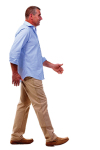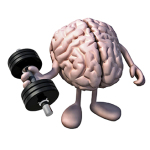Walk vs Run: Surprising News.
Posted on November 30, 2014 by bob in NewsUCanUse
If You Can’t Run, Walk
Running can be a daunting if not impossible activity, especially if you’re not in the best of health. However, you can walk your way to the same rewards you’d get by running. Over a six year period researchers analyzed more than 33,000 runners in the National Runners’ Health Study, plus more than 15,000 walkers in the National Walkers’ Health Study. Study participants were 18 to 80 years old, with most in their 40s and 50s.
Researchers focused on time, not distance, and found that brisk walking (considered moderate intensity), compared to running, produced similar risk reductions for hypertension, diabetes, high cholesterol and possibly heart disease.
While running significantly cut the risk for first-time hypertension by 4.2%, walking cut the risk by 7.2%. Similar risk reductions were found for first-time high cholesterol (4.3% for running, 7% for walking) and first-time diabetes (12.1% for running, 12.3% for walking).
Most adults should get 150 minutes a week of moderate-intensity exercise, with at least two days of strength-training exercises.
(Arteriosclerosis, Thrombosis and Vascular Biology. John Hopkins Health Alert, www.johnshopkinshealthalerts.com.)
Mother DOES Know Best
The amount of education a mother attains, and the age at which she has children, can help predict her children’s success in reading and math. A new study from the University of Michigan says children of mothers 19 and older usually enter kindergarten with higher levels of achievement than children of mothers 18 and younger. The good news is that the children of teen mothers who continue their education after having children do better academically than children of teen moms who did not continue, though the study predicts children of younger mothers never catch up.
Data analyses took into account mothers’ educational expectation for their children, the home environment and other characteristics, such as household income, that may influence children’s achievement.Trends indicate that mothers who give birth during adolescence have much lower rates of high school completion and college enrollment in comparison to their counterparts who delay pregnancy.
These patterns highlight the importance of investing in early interventions that target adolescent mothers to provide them with the skills needed to promote their children’s learning.
(Journal of Research on Adolescence, University of Michigan, posted by Science Daily, www.sciencedaily.com.)
Your Eyes and Dementia
Changes to the eyes might help diagnose the onset of frontotemporal dementia (FTD), the second most common form of dementia, according to new research from scientists at the University of Alabama at Birmingham, Gladstone Institutes and the University of California, San Francisco.
Findings published in the Journal of Experimental Medicine show a loss of cells in the retina, even before any changes appear in their behavior, is one of the earliest signs of FTD in people with a genetic risk for the disorder.
The researchers studied a group of individuals who had a certain genetic mutation that is known to result in FTD. Before any cognitive signs of dementia were present, these individuals showed a significant thinning of the retina compared with people who did not have the gene mutation.
“This finding suggests that the retina acts as a type of window to the brain,” said Erik Roberson, M.D., Ph.D., associate professor in the Department of Neurology at UAB and a study co-author.
Although it is located in the eye, the retina is made up of neurons with direct connections to the brain. This means studying the retina is one of the easiest and most accessible ways to examine and track changes in neurons.
(This and other stories available at www.uab.edu/news.)
Exercise and Cognitive Decline: Good News
All mental functions, including memory, depend on an adequate supply of blood to the brain. Regular physical activity promotes better mental functioning by improving cerebral blood flow. Research based on objective assessments of physical activity has begun to help doctors determine how much activity might make a difference.
For their four-year study, researchers recruited 716 individuals with an average age of 82 who did not have dementia. Initially, participants wore an actigraph for 10 days. This device provides an objective measure of all physical activity, including such things as washing dishes and playing cards. Memory and cognitive abilities were assessed yearly and participants self-reported physical and social activities. Over the course of the study, 71 participants developed Alzheimer’s disease.
People in the bottom 10% of total daily physical activity were more than twice as likely to develop Alzheimer’s disease as people in the top 10%. Those in the bottom 10% of intensity of physical activity were almost three times as likely to develop AD as people in the top 10%.
These findings don’t prove physical activity can ward off Alzheimer’s disease, but do suggest all types of physical activity are beneficial.
(Journal Neurology, posted by Johns Hopkins, www.johnshopkinshealthalerts.com/.)
Beware of the “Health Halo”
When consumers see a company performing good deeds, they often assume the company’s products are healthy. According to a new study this may be far from true, and the company’s socially responsible behavior may be creating a positive feeling in consumers, termed a ”health halo,” that carries over to unhealthy foods.
According to the study, a collaboration between the University of Kentucky, Westminster College and Florida State University, consumers often infer a company’s product is healthy based on that company’s good deeds, often showcased in advertising and marketing campaigns. This “health halo” encourages overconsumption and underestimation of calories.
The study warned that consumers seeking healthy food choices should not base their selection on companies with strong reputations for corporate social responsibility.
(Journal of Public Policy & Marketing. Posted by Science Daily, www.sciencedaily.com.)













